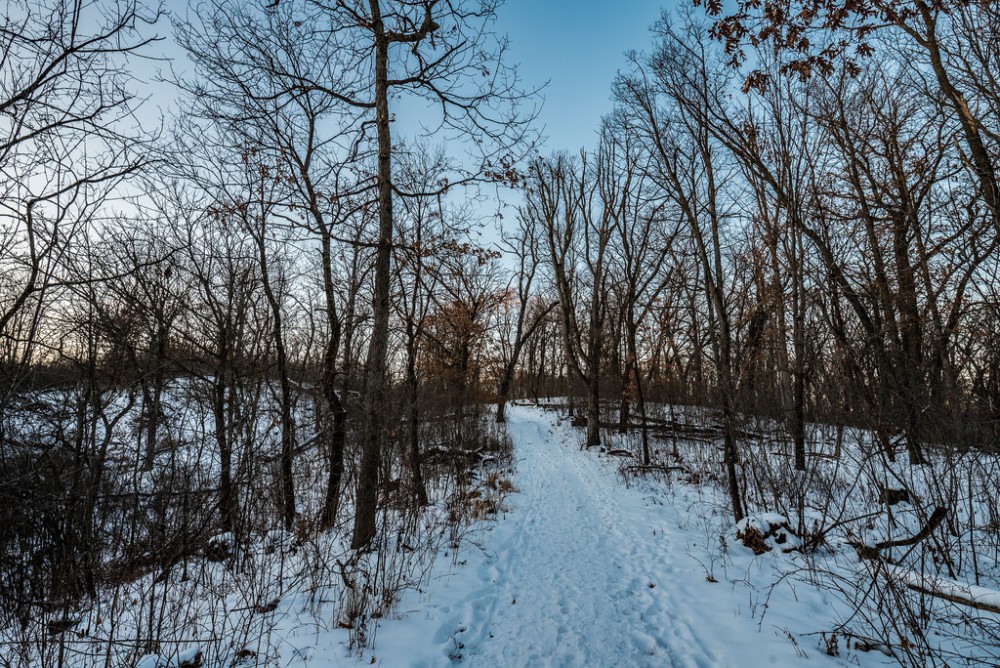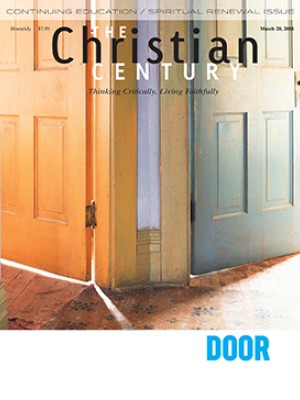Four o’clock p.m. Twelve below zero. I had just arrived at St. John’s Abbey, a Benedictine monastery, and was walking around Lake Sagatagan. My destination was Stella Maris (“Star of the Sea”), a tiny red brick chapel built by the monks more than a century ago. It was much farther than I remembered. Or maybe it was just cold. Or the wind. I last visited in August. Then people were swimming and kayaking.
A single trail of footprints led out to the middle of the lake, where a man kneeled on the ice in the brutal wind. He was very still. Waiting. Ice fishing. I assumed. Or maybe praying. Maybe both. That day they seemed like the same thing. Any fish that appeared would surely be a sign from God. As I walked along the bank I could soon make out the auger he’d used to drill the hole, and a little rod and a silver can. But no fish, or shelter from the wind.
Read our latest issue or browse back issues.
A half hour later I arrived at the chapel. It was warmer inside—maybe 15 above. I said a prayer of gratitude. That’s why I had come. To thank the Creator for time to create. “Thank you for shmita, for a sabbath year to read and write and pray,” I said to the empty room, to the frozen stones and small wooden pew.
It was then I noticed the orange and blue rays of sunlight flooding through the stained glass. The warm shafts of color felt like answers to a question I didn’t know how to ask.
“Attentiveness without an aim is the supreme form of prayer,” writes Simone Weil. But we need time to attend. Not the frenetic, multipresent “convenience” of digital time, but slow time to wait and wonder—like the fisherman out there on the ice. Time to dream of the vast world beneath the frozen surface—to believe in the unseen, and a kind of time that cannot be measured.
I walked back around the lake and pondered what I hoped to write that year––stories of travel, both physical and spiritual. Not stories of arrival––but of being lost, and found, and lost again. Not only “a journey into space,” as Nelle Morton once wrote, “but a journey into presence.” Not tours, but unmarked detours. Detours of intention, which can be read two ways: sometimes I chose the route, but more often it chose me.
A prayer is also a detour of intention. We don’t know where we’re going. “Prayer is not asking for what you think you want,” writes Kathleen Norris, “but asking to be changed in ways you can’t imagine.” So we choose to wait and to listen. But for how long? Five minutes? A week? And to what or whom? Mystery. Sometimes only silence. The presence of absence. But sometimes a shivering sense of belonging rises up, even amid the icy rocks and creaking trees.
When I headed back to the abbey, the kneeling man was still out there fish-praying. But still no fish. I had no desire to join him in the middle of the frozen lake, but I felt some sympathy and connection, as that’s what I’d be doing all year—waiting, praying, and a kind of fishing—for words and Word, and a different kind of time. For what Henry David Thoreau once called “the gospel of this moment.”
That afternoon as I tramped around the lake I was thinking of Thoreau’s essay “Walking,” which I often reread as it reminds me how to pray, and how to imagine “the holy land,” which for Thoreau is wherever you are. It’s not a place but a kind of presence, a prayerful attention—which I’m not very good at, which is why I keep walking. And walking. I’m searching for the gospel of screeching ravens and snowy pine boughs and curling wood smoke.
“We travel, initially, to lose ourselves,” writes Pico Iyer, “and we travel, next, to find ourselves.” Iyer has written a dozen travel books about exotic far-flung cultures—from the Philippines to Katmandu. I loved these books, but the one I reread is a critique of all the others: The Art of Stillness: Adventures in Going Nowhere, in which Iyer explores the necessity of the inner journey. The thesis of his book is suggested in a line he borrows from Thoreau: “It matters not where or how far you travel—the farther commonly the worse—but how much alive you are.”
When we travel we are always looking out at the physical world with the eye and in at the self, at the I. This delicate, difficult braid of self and world, of both seeing and seeking, is for me at the heart of the writing process. But it’s also at the heart of prayer. Seers and seekers. Seeing and seeking. Where does one end and the other begin? Do they ever converge?
I carried these questions with me, as I tramped from the lake up the hill, to the abbey, for five o’clock prayers with the monks. Happy to be someplace warm, I filed into the choir and sat down in one of the heavy oak choir stalls. There are four daily prayers in the liturgy of the hours at St. John’s. But on the shelf in front of me were seven prayer books: seven little blue plastic binders, the kind with three holes and silver rings. Which book? Morning, Midday, Evening, Book of Song, Feasts, Common, or Responses/Canticles? I chose Evening, and a thin, black-robed monk behind me immediately came up and pulled out the Book of Song. “This is Mass 8,” he said quietly, and opened the book to the Psalms for Monday, Week 1 in Ordinary Time.
When I still couldn’t find the eighth mass, I sort of came undone. I’m not sure why or how I jumped from my “gospel of this moment” meditations at the lake to that anxious, agitated “What am I doing here?” moment. Why was I more comfortable in the freezing forest sanctuary than in that toasty warm one? I preferred being outside to being an outsider. I felt like a tourist. Like I was looking at rather than seeing. And why wouldn’t I? Aside from not knowing which prayer book to use, I wasn’t Catholic, didn’t really know how to pray, or cross myself, or bless myself with holy water, or chant psalms melodically, or bow at the right times, or if I should take communion, or how time could be ordinary, or anything else.
That was when my guardian monk returned, opened the prayer book to Mass 8, the hymnal to page 82, and nodded toward the signboard on the wall which listed all the info for the day—the week, mass, song, and psalm. He knew I hadn’t noticed it and smiled gently.
“Thank you,” I said.
“You’re welcome,” he replied. But in his kind, calm eyes, I heard a third word. Or did I just want to hear it? I couldn’t know for sure. Did it matter? Yes. Why not believe in the word?
You’re welcome here. Even if you don’t know where you’re going or how you’ll arrive.
It was a prayer I didn’t expect or know I’d been waiting for.
A version of this article appears in the print edition under the title “Detours of prayer.”






